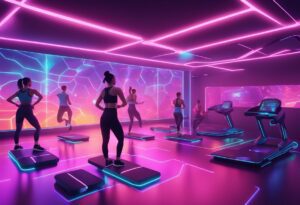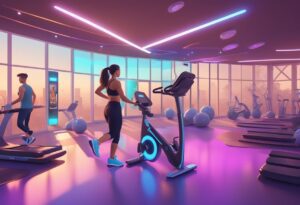The concept of the metaverse has taken the world by storm, and it is not just limited to gaming and entertainment. Fitness enthusiasts are now exploring the potential of the metaverse as a new frontier for their workouts. With the advent of technology and virtual reality, the metaverse provides a unique opportunity for fitness enthusiasts to engage in workouts that are not just fun but also effective. In this article we will discuss the concept of metaverse fitness. I will share with you a step by step guide on how to start fitness in the metaverse.
The metaverse is essentially a virtual world where individuals can explore, interact, and engage in various activities. It has gained strong interest and speculation in recent years, and fitness is one of the areas where it has shown tremendous potential. The metaverse provides a platform for fitness enthusiasts to engage in workouts that are not just limited to the physical world but also incorporate virtual reality and other technologies.
Evolution of Fitness in the Metaverse
The evolution of fitness in the metaverse can be traced back to the early days of virtual reality technology. The first VR fitness equipment was introduced in the 1990s, but it was not until the 2010s that VR fitness started to gain popularity.
The introduction of consumer VR headsets like Oculus Rift and HTC Vive in 2016 paved the way for the development of immersive fitness experiences in the metaverse.
Current Trends
Currently, fitness in the metaverse is dominated by VR fitness games and immersive virtual workouts. VR fitness games like Beat Saber and BoxVR have gained a huge following, providing users with a fun and engaging way to exercise.
Immersive virtual workouts, on the other hand, use VR headsets to create a more immersive workout experience. Users can work out in virtual environments like a beach or a forest, making the workout more enjoyable.
Future Projections
The future of fitness in the metaverse looks promising, with many innovations expected to emerge. One of the most exciting developments is the use of haptic feedback technology in VR fitness equipment.
Haptic feedback technology provides users with a tactile sensation, making the experience more realistic. Another innovation is the use of AI to personalize workouts. AI algorithms can analyze user data to create personalized workout plans that are tailored to individual needs.
As the fitness industry continues to embrace VR fitness and wellness, the metaverse is expected to play a significant role in the future of fitness. The fusion of physical fitness and virtual gaming is expected to revolutionize the way we approach fitness, offering a more engaging and personalized experience.
Technology required to start fitness in the metaverse
Virtual Reality (VR) Headset
A VR headset is the most crucial piece of technology for experiencing fitness in the metaverse. It provides the immersive visual and auditory experience that defines virtual reality. Popular options include:
- Oculus Quest 2: A standalone headset with no need for a PC connection.
- HTC Vive: Known for its high-quality display and tracking capabilities.
- Valve Index: Offers high-fidelity visuals and precise motion tracking.
- PlayStation VR: A console-based VR option for PlayStation users.
Motion Tracking Controllers or Sensors
Most VR headsets come with motion controllers that track your hand movements. Some systems may also use external sensors placed around your room to track full-body movement more accurately.
Adequate Play Space
You need a clear area with enough space to move around safely without hitting any obstacles. The amount of space required can vary depending on the activity but generally, a few square meters of unobstructed space should suffice.
High-Speed Internet Connection
A stable and fast internet connection is necessary to download VR fitness apps and, if applicable, to stream live classes or interact with others in real-time within the metaverse.
VR Fitness Application or Platform
You’ll need to choose a VR fitness application or a metaverse platform that offers fitness experiences. Some platforms may be standalone apps dedicated to fitness, while others might be part of a broader virtual world that includes fitness activities.
Accessories for Comfort and Safety
- Exercise Mat: A non-slip mat can provide better footing and cushioning for floor exercises.
- VR Cover: A sweat-resistant cover for your VR headset can make your workout more comfortable and hygienic.
- Wrist Straps: To prevent the controllers from slipping out of your hands during vigorous movements.
Optional: Additional Fitness Equipment
Some VR fitness experiences might integrate with or simulate the use of additional fitness equipment like:
- Resistance Bands: For strength training exercises.
- Stationary Bicycle: For VR cycling experiences.
- Treadmill: Specialized VR treadmills can allow you to walk or run in place.
Optional: Haptic Feedback Devices
These devices can enhance the immersive experience by providing tactile feedback. They can range from simple vibration feedback in controllers to more advanced wearable vests that simulate the feeling of touch.
Before purchasing any equipment, ensure it’s compatible with the fitness applications you intend to use and that you have the physical space to accommodate it. As the metaverse and VR technology continue to evolve, new devices and platforms that enhance virtual fitness experiences are likely to emerge.

How to start fitness in the metaverse
Starting a fitness workout in the metaverse involves a combination of virtual reality technology and traditional exercise routines. Here’s a step-by-step guide to get started with fitness workouts in the metaverse:
Step 1: Choose Your Platform
Research and select a metaverse platform that offers fitness workouts. Some popular options may include VR fitness games or virtual gyms within platforms like VRChat or dedicated fitness apps in the metaverse.
Step 2: Acquire Necessary Hardware
To fully immerse yourself in a metaverse workout, you’ll need a virtual reality headset. Options range from high-end headsets like the Oculus Quest or Valve Index to more affordable options that work with your smartphone. Ensure you have enough space to move around safely.
Step 3: Set Up Your Equipment
Follow the instructions to set up your VR headset. This typically involves installing software on your PC or a companion app on your smartphone, calibrating the headset, and setting up any motion tracking sensors if required.
Step 4: Create an Account
Once your headset is ready, create an account on the metaverse platform you’ve chosen. This may involve downloading the platform’s app onto your headset and following the registration process.
Step 5: Customize Your Avatar
Many metaverse platforms allow you to create and customize an avatar. Take the time to design your virtual representation to enhance your sense of presence during workouts.
Step 6: Explore Fitness Options
Navigate through the platform to explore the various fitness options available. This could include on-demand classes, live sessions with trainers, or interactive fitness games.
Step 7: Select a Workout
Choose a workout that aligns with your fitness goals and interests. This could be anything from yoga and pilates to high-intensity interval training (HIIT) or virtual reality games that get your body moving.
Step 8: Prepare Your Space
Clear enough space in your physical environment to ensure you can move freely without the risk of bumping into furniture or walls. Have a water bottle nearby and a towel if needed.
Step 9: Join the Workout
Follow the instructions to join the workout session. This might involve loading a specific environment, joining a live class, or starting a fitness game.
Step 10: Engage and Exercise
Participate in the workout by following the trainer’s instructions or the game’s objectives. Ensure you’re performing movements correctly to avoid injury.
Step 11: Track Your Progress
Some metaverse fitness platforms may offer progress tracking. Use these tools to monitor your workouts, set goals, and track improvements over time.
Step 12: Cool Down and Reflect
After your workout, take time to cool down. Reflect on your performance and how the virtual environment may have enhanced your workout experience.
Step 13: Stay Consistent
Consistency is key to fitness. Schedule regular workouts in the metaverse and explore different types of exercises to keep your routine engaging.
Step 14: Connect with the Community
Many metaverse platforms have a community aspect. Connect with other users, share experiences, and find workout buddies for motivation and support.

Technological Foundations
Virtual Reality and AI
Virtual reality (VR) and artificial intelligence (AI) are two of the most important technologies that have made fitness in the metaverse possible.
VR headsets like Oculus have made it possible for users to experience a fully immersive workout environment, while AI has enabled personalization and customization of workout routines based on individual preferences and needs.
With VR technology, users can participate in virtual fitness classes, engage in virtual sports, and explore virtual environments. This technology has made it possible for users to experience the benefits of physical fitness without leaving their homes.
AI has enabled fitness apps and platforms to provide personalized and customized workout routines for users based on their fitness goals, preferences, and abilities.
Blockchain and Cryptocurrencies
Blockchain technology and cryptocurrencies have also played a significant role in the development of fitness in the metaverse. Blockchain technology has enabled the creation of decentralized fitness platforms that allow users to earn tokens for participating in fitness activities and challenges. These tokens can then be exchanged for other cryptocurrencies or used to purchase fitness-related products and services.
Cryptocurrencies have also made it possible for users to participate in virtual fitness classes and activities from anywhere in the world without the need for a traditional payment system. This has made fitness more accessible and affordable for users worldwide.
The combination of VR, AI, blockchain, and cryptocurrencies has made fitness in the metaverse a reality. These technologies have enabled users to experience the benefits of physical fitness in a virtual environment, while also providing new opportunities for personalization, customization, and participation in fitness-related activities.
Virtual Fitness Experiences
With the rise of the metaverse, fitness enthusiasts are now able to experience a new dimension of virtual fitness experiences. These experiences are designed to be immersive, fun, and engaging, providing a unique way to exercise.
Gaming and Exercise
One of the most popular virtual fitness experiences in the metaverse is gaming and exercise. With games like Supernatural, players can experience a full-body workout that feels more like a game than exercise.
Players are transported to beautiful, virtual environments where they must dodge, duck, and jump to avoid obstacles and hit targets. The game is designed to be fun and engaging, making it a great way to get a workout without feeling like you’re exercising.
VR Workouts and Classes
Virtual reality (VR) workouts and classes are another popular way to exercise in the metaverse. With VR technology, users can experience a full-body workout that feels like they’re in a real gym. Users can participate in virtual boxing classes, dance classes, and other virtual workouts.
These classes are led by virtual trainers who provide guidance and motivation, making it a great way to get a workout in while also having fun.
Vrtual fitness experiences in the metaverse are a fun and engaging way to exercise. With the rise of VR technology, users can experience a full-body workout without leaving their home. Whether you prefer gaming and exercise or virtual workouts and classes, there’s something for everyone in the metaverse.
Social and Economic Aspects of Metaverse fitness
The metaverse has brought about a new era of social and economic opportunities. Fitness enthusiasts can now participate in virtual fitness communities where they can interact with other users and compete in fitness challenges. The following subsections highlight some of the social and economic aspects of fitness in the metaverse.
Community and Competition
The metaverse provides a platform for fitness enthusiasts to connect with like-minded individuals and form communities. Users can create avatars and participate in virtual fitness classes or challenges. These communities offer a sense of belonging and motivation to users, encouraging them to maintain their fitness goals.
Competition is also an essential aspect of fitness in the metaverse. Users can compete against each other in fitness challenges, which can be a great way to push themselves to achieve their fitness goals. The use of game assets and NFTs can add to the competitive nature of these challenges, making them more exciting and rewarding.
Monetization and Ownership
Fitness in the metaverse can also be a source of income for users. Subscription fees can be charged for access to virtual fitness classes or challenges. Users can also monetize their fitness content by creating and selling NFTs or game assets related to fitness.
Ownership is another important aspect of fitness in the metaverse. Users can own virtual fitness equipment and spaces, which can be customized to suit their preferences. This ownership provides users with a sense of control over their fitness environment and can motivate them to maintain their fitness goals.
The metaverse provides a platform for fitness enthusiasts to connect with others, compete in challenges, and monetize their fitness content. Ownership of virtual fitness equipment and spaces can also provide users with a sense of control over their environment.
Adoption and Integration
The metaverse is an exciting new frontier for fitness enthusiasts. With the rise of virtual reality technology and the increasing popularity of at-home fitness, it’s no surprise that fitness in the metaverse is quickly gaining traction. In this section, we’ll explore how fitness is being adopted and integrated into the metaverse.
From Gyms to Virtual Spaces
Gyms have long been a staple of the fitness industry, but with the rise of the metaverse, virtual spaces are quickly becoming the go-to destination for fitness enthusiasts. Companies like FitXR are leading the way with virtual fitness classes that allow users to work out in immersive environments. These virtual spaces offer a unique experience that can’t be replicated in a traditional gym setting.
In addition to virtual fitness classes, gyms are also starting to integrate into the metaverse. Peloton, for example, has announced plans to launch a virtual reality platform that will allow users to ride through virtual worlds. This integration of traditional fitness companies into the metaverse is a sign of the growing popularity of fitness in virtual spaces.
Home Fitness Revolution
The rise of at-home fitness has been a game-changer for the fitness industry, and it’s no different in the metaverse. With virtual fitness classes and workouts available at the click of a button, users can work out from the comfort of their own homes. This has led to a surge in popularity for at-home fitness equipment, such as Peloton bikes and NordicTrack treadmills.
One of the biggest advantages of at-home fitness in the metaverse is the convenience factor. Users can work out on their own schedule, without having to worry about gym membership fees or crowded workout spaces. This has led to a revolution in the fitness industry, with more and more people opting to work out from home.
The adoption and integration of fitness into the metaverse is an exciting development for fitness enthusiasts. With virtual fitness classes and immersive workout experiences, the metaverse offers a unique and exciting way to stay fit and healthy.

Frequently Asked Questions
What virtual reality equipment is needed to participate in metaverse fitness programs?
To participate in metaverse fitness programs, one will need a virtual reality headset, compatible controllers, and a powerful computer to run the software. The headset will allow users to immerse themselves in a virtual environment, while the controllers will enable them to interact with the virtual world.
Can you track real-world fitness progress within the metaverse?
Yes, tracking real-world fitness progress is possible within the metaverse. Some virtual fitness programs are designed to sync with fitness wearables or apps to track metrics such as heart rate, calories burned, and steps taken. This allows users to monitor their progress and make adjustments to their workout routine as needed.
What are the most popular metaverse platforms for virtual workouts?
Currently, some of the most popular metaverse platforms for virtual workouts include VR fitness apps such as Supernatural, BoxVR, and Beat Saber. These apps offer a range of workout routines, from dance-based cardio to high-intensity interval training.
How do virtual gyms in the metaverse differ from traditional gyms?
Virtual gyms in the metaverse offer a unique experience that differs from traditional gyms. Users can exercise in a virtual environment that is tailored to their preferences and goals, without the distractions or limitations of a physical gym. Virtual gyms often offer a social component, allowing users to connect and workout with others from around the world.
Are there competitive sports leagues within the metaverse?
Yes, there are competitive sports leagues within the metaverse. Some virtual reality games, such as Echo Arena, offer multiplayer modes where players can compete against each other in a variety of sports, including basketball, football, and even ultimate frisbee.
What are the benefits of engaging in fitness activities in a virtual environment?
Engaging in fitness activities in a virtual environment can offer several benefits. It can provide a fun and engaging way to exercise, making it easier to stick to a workout routine. Virtual workouts can also be tailored to individual preferences and fitness levels, allowing users to challenge themselves in a safe and controlled environment. Virtual workouts can provide a sense of community and connection, allowing users to connect and workout with others from around the world.




